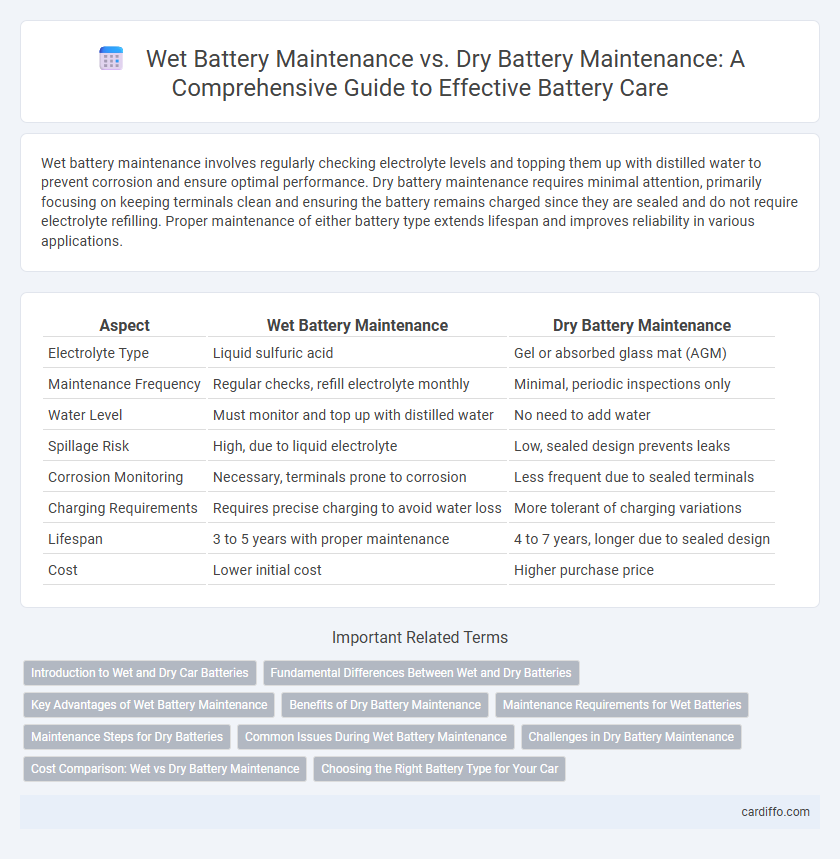Wet battery maintenance involves regularly checking electrolyte levels and topping them up with distilled water to prevent corrosion and ensure optimal performance. Dry battery maintenance requires minimal attention, primarily focusing on keeping terminals clean and ensuring the battery remains charged since they are sealed and do not require electrolyte refilling. Proper maintenance of either battery type extends lifespan and improves reliability in various applications.
Table of Comparison
| Aspect | Wet Battery Maintenance | Dry Battery Maintenance |
|---|---|---|
| Electrolyte Type | Liquid sulfuric acid | Gel or absorbed glass mat (AGM) |
| Maintenance Frequency | Regular checks, refill electrolyte monthly | Minimal, periodic inspections only |
| Water Level | Must monitor and top up with distilled water | No need to add water |
| Spillage Risk | High, due to liquid electrolyte | Low, sealed design prevents leaks |
| Corrosion Monitoring | Necessary, terminals prone to corrosion | Less frequent due to sealed terminals |
| Charging Requirements | Requires precise charging to avoid water loss | More tolerant of charging variations |
| Lifespan | 3 to 5 years with proper maintenance | 4 to 7 years, longer due to sealed design |
| Cost | Lower initial cost | Higher purchase price |
Introduction to Wet and Dry Car Batteries
Wet car batteries contain liquid electrolyte that requires regular water level checks and refilling to prevent damage and ensure optimal performance. Dry car batteries, also known as sealed or maintenance-free batteries, utilize a gel or absorbed glass mat (AGM) electrolyte that eliminates the need for water refills while offering greater resistance to vibrations and spills. Understanding the fundamental differences in design and maintenance requirements between wet and dry batteries is essential for maximizing battery lifespan and maintaining reliable vehicle operation.
Fundamental Differences Between Wet and Dry Batteries
Wet battery maintenance involves regular inspection of electrolyte levels, topping up with distilled water, and ensuring terminals are clean to prevent corrosion, as these batteries contain liquid electrolyte that can evaporate or leak. Dry battery maintenance requires less frequent attention since sealed lead-acid or lithium-ion dry batteries contain immobilized electrolyte, reducing risks of spills and the need for refilling. Fundamental differences between wet and dry batteries include the electrolyte state--liquid versus immobilized--and their maintenance complexity, where wet batteries demand more hands-on care for optimal performance and longevity.
Key Advantages of Wet Battery Maintenance
Wet battery maintenance offers superior electrolyte level management, ensuring optimal chemical reactions and prolonging battery life. Regular topping up with distilled water prevents sulfation and corrosion on battery plates, enhancing performance and reliability. This maintenance method supports better charge acceptance and sustained power output compared to dry batteries.
Benefits of Dry Battery Maintenance
Dry battery maintenance offers enhanced safety by eliminating the risk of acid leaks and corrosion commonly associated with wet batteries. Longer lifespan and reduced maintenance frequency contribute to lower overall operational costs, making dry batteries more cost-effective in the long term. Improved portability and resistance to vibration make dry batteries ideal for applications in automotive and renewable energy storage systems.
Maintenance Requirements for Wet Batteries
Wet batteries require regular maintenance, including checking and refilling electrolyte levels with distilled water to prevent sulfation and ensure optimal performance. Periodic cleaning of terminals and inspection for corrosion are essential to maintain conductivity and prolong battery life. Proper ventilation during charging is necessary to avoid gas buildup, enhancing safety and efficiency in wet battery systems.
Maintenance Steps for Dry Batteries
Dry battery maintenance involves regularly inspecting terminals for corrosion, ensuring tight connections, and cleaning any buildup with a mixture of baking soda and water. Monitoring voltage levels helps detect early signs of deterioration, while keeping the battery in a cool, dry environment prevents overheating and extends battery lifespan. Periodic testing using a multimeter confirms battery health and readiness for use.
Common Issues During Wet Battery Maintenance
Common issues during wet battery maintenance include electrolyte level fluctuations caused by evaporation or overfilling, leading to reduced battery performance. Corrosion on terminals and connectors frequently occurs due to acid leaks, requiring regular cleaning to prevent power loss. Additionally, sulfation buildup on the battery plates can impair charging efficiency and shorten battery lifespan if not addressed promptly.
Challenges in Dry Battery Maintenance
Dry battery maintenance poses significant challenges due to the sealed design that limits access to internal components, preventing electrolyte level checks and refills. The risk of permanent damage increases if the battery experiences overcharging or deep discharge, as there is no way to replenish lost electrolytes. Temperature sensitivity and the potential for internal corrosion exacerbate the difficulty in maintaining optimal performance in dry cell batteries.
Cost Comparison: Wet vs Dry Battery Maintenance
Wet battery maintenance generally incurs lower upfront costs due to simpler construction and easier access for electrolyte refilling, but requires regular monitoring and distilled water additions to prevent sulfation and extend battery life. Dry battery maintenance involves higher initial investment with sealed, maintenance-free designs that eliminate the need for electrolyte level checks, reducing labor costs while offering longer service intervals and enhanced safety. Over time, dry batteries tend to present lower total maintenance expenses despite higher purchase prices, making them cost-effective for applications prioritizing reliability and reduced downtime.
Choosing the Right Battery Type for Your Car
Selecting the right battery type for your car involves understanding the differences between wet and dry batteries, where wet batteries require regular electrolyte level checks and water replenishment to prevent corrosion and maintain performance. Dry batteries, also known as maintenance-free batteries, offer sealed designs that eliminate the need for watering, reducing upkeep while providing reliable starting power, especially in modern vehicles with advanced electrical systems. Choosing between wet and dry batteries depends on your vehicle's requirements, climate conditions, and willingness to perform routine maintenance, ensuring optimal battery lifespan and vehicle operation.
Wet Battery Maintenance vs Dry Battery Maintenance Infographic

 cardiffo.com
cardiffo.com